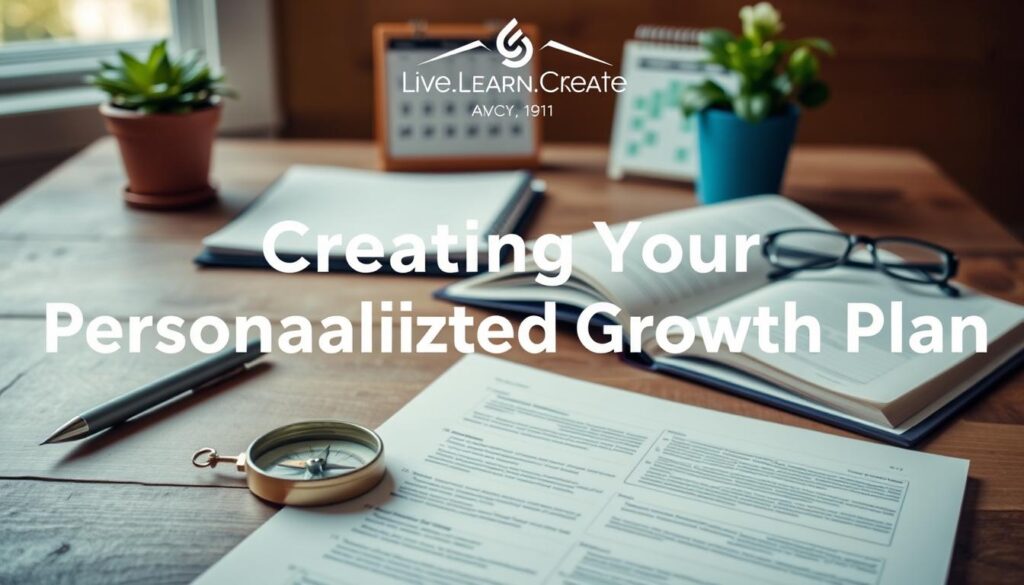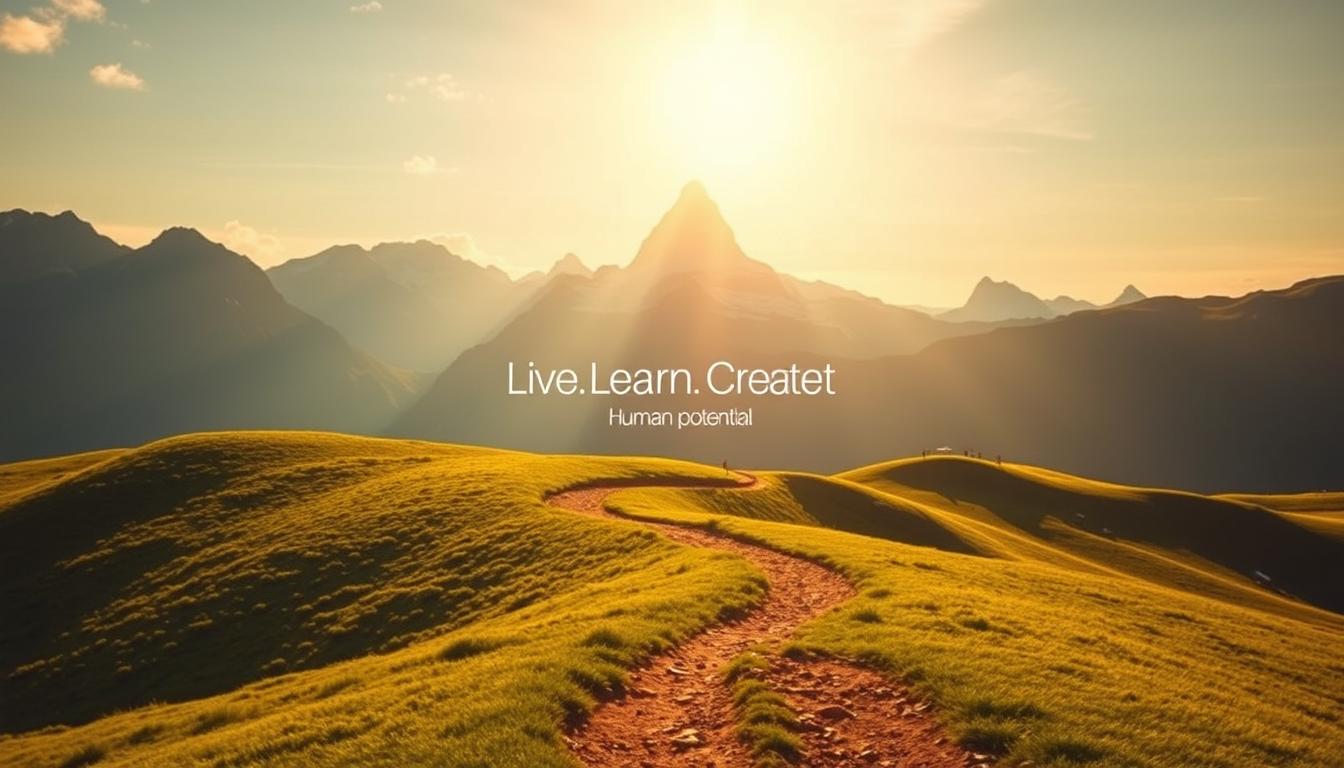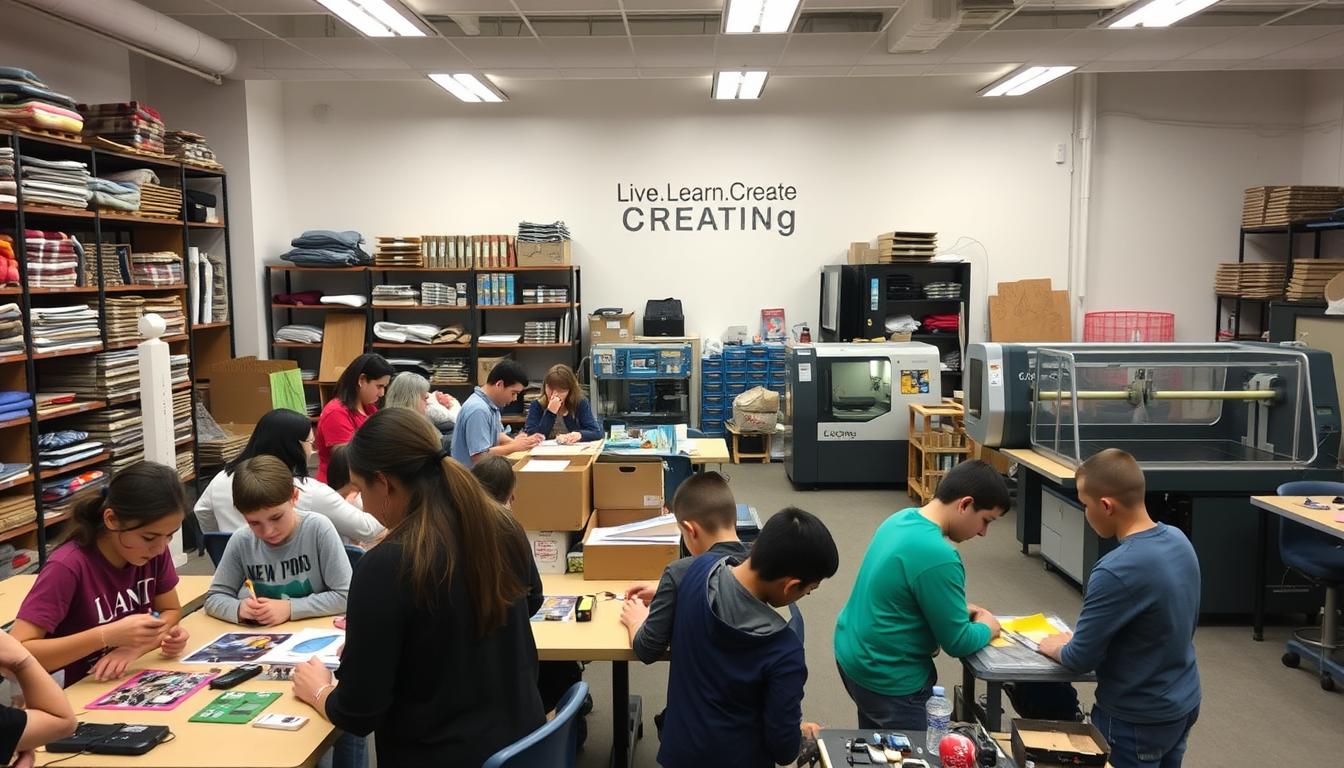What if the secret to a fulfilling life isn’t found in rigid plans—but in the unexpected twists of your journey? Writing across genres taught me that. From thrillers to poetry, each style shaped my mindset—and my path forward.
With 19 international awards and certifications in mindfulness and CBT, I’ve seen how creativity mirrors development. The same flexibility that crafts a mystery novel also helps navigate life’s uncertainties. Every blank page is a chance to evolve.
This isn’t about reaching a final destination. It’s about the small shifts—how a poet’s attention to detail sharpens decision-making, or how fiction’s “what if” questions spark real-world problem-solving. Let’s explore how writing transforms more than stories.
Key Takeaways
- Writing across genres builds adaptable thinking for life’s challenges
- Creative skills directly translate to personal and professional growth
- Mindfulness techniques enhance both writing and life clarity
- Progress matters more than perfection in any journey
- Emotional and mental development are deeply interconnected
Introduction: Why Personal Growth Matters
The journey to becoming your best self starts with small steps. I remember staring at a shelf of self-help books, drowning in terms like “manifestation” and “quantum leaps.” It felt overwhelming—like growth was a club I hadn’t earned a ticket to. But here’s what I learned: progress beats perfection every time.
Psychology backs this up. Maslow’s hierarchy places self-actualization—reaching your full potential—at the peak of human needs. It’s not about chasing happiness; it’s about lasting fulfillment. Temporary highs fade, but growth sticks.
Today’s world demands adaptability. Whether it’s career shifts or personal challenges, resilience is non-negotiable. That’s why I created the “Get Your Life Together” philosophy during my Instagram Live sessions. No jargon, just real talk about:
- Breaking big goals into tiny, doable steps
- Celebrating progress, not just end results
- Seeing setbacks as setups for comebacks
This isn’t another rigid program. It’s a way of life—one that honors your unique path.
Defining Personal Growth vs. Personal Development
Think of your potential like a garden—what tools help it flourish? For years, I blurred the lines between development and growth. Then I realized: one fuels the other. Development is the shovel; growth is the bloom.

What Is Personal Development?
It’s the how—the actionable steps. Like stocking a kitchen before cooking, development builds your toolkit. My favorite 10 tools:
- Morning journaling (clarity)
- Online courses (new skills)
- Strength assessments like HIGH5 (self-awareness)
- Coaching sessions (accountability)
- Meditation (focus)
What Is Personal Growth?
This is the why—the tangible wins. When I committed to daily writing (development), my income jumped 40% in a year (growth). Other outcomes:
- Deeper confidence in decisions
- Stronger boundaries in relationships
- Faster problem-solving at work
How They Work Together
Fiction writing taught me this balance. Drafting a novel (development) sharpens patience; publishing it (growth) builds resilience. The HIGH5 test bridged both—it revealed my “Innovator” strength, which I now leverage in every project.
Your turn: Pick one tool this week. Notice how small shifts create big blooms.
The Life-Changing Benefits of Personal Growth
Ever noticed how small changes ripple into life-altering results? What starts as a five-minute journaling habit can quiet anxiety—or a single networking conversation might unlock a career breakthrough. The rewards of nurturing your potential extend far beyond checklists.
Improved Mental and Emotional Health
During my third book launch, crippling anxiety made promotions unbearable. Then I committed to daily journaling—not just goals, but fears. Within weeks, my stress halved. Science explains why: neuroplasticity shows our brains rewire through consistent practice.
Research confirms it. A study of life coaching clients found 80% reported lasting confidence boosts after six months of growth-focused habits. Chronic stress? It drops when we prioritize progress over perfection.
“Growth isn’t about fixing yourself—it’s about befriending your evolving mind.”
Stronger Relationships
Fiction writing taught me this: deep characters need layers. Real-life connections thrive the same way. When I applied active listening (a skill honed drafting dialogue), my relationships transformed.
- Partners felt heard, not just “managed”
- Colleagues trusted my input faster
- Conflict became collaborative, not combative
Career and Financial Success
Growth-oriented professionals earn 23% more on average (Harvard Business Review). Why? They view challenges as skill-builders. One client doubled her freelance income by reframing rejections as “data points.”
| Growth Habit | Career Impact |
|---|---|
| Morning learning sessions | Faster promotions |
| Feedback analysis | Stronger client retention |
| Networking with intent | Higher-paying opportunities |
Your turn: Which benefit—health, relationships, or success—would most transform your life this year? Start there.
How to Cultivate a Growth Mindset
Growth isn’t about avoiding obstacles—it’s about learning to dance with them. Early in my writing career, I collected rejection letters like badges of honor. Each “no” taught me the difference between a fixed mindset (“I’m not good enough”) and a growth mindset (“This is how I’ll improve”).

Embracing Challenges
I started a “failure résumé”—a practice inspired by Kristina Mänd-Lakhiani’s curiosity-driven philosophy. For every genre I wrote (thrillers, poetry, even cookbooks), I logged rejections and lessons. One publisher’s critique of my mystery novel? It became the way I learned to tighten plot twists.
Learning from Failure
Mystery writing taught me to see setbacks as clues, not dead ends. When plotting novels, I’d ask: “What if the villain’s mistake reveals their weakness?” Now, I apply that to goals. A missed deadline isn’t failure—it’s data to adjust my process.
Celebrating Progress
Between writing sessions, I practice a 3-sentence ritual:
- “Today, I learned…” (skill)
- “I’m proud of…” (effort)
- “Tomorrow, I’ll try…” (progress)
This tiny habit buildsresilience—and makes growth visible.
“A growth mindset turns ‘I can’t’ into ‘I can’t yet.’”
Actionable tip: This week, reframe one challenge as a curiosity experiment. Ask: “What if this obstacle is here to teach me something new?” Like a mystery novel, the answers might surprise you.
5 Key Areas of Personal Growth
The path to transformation isn’t one road—it’s five interconnected trails waiting to be explored. Just as my multi-genre writing spans mysteries to poetry, thriving in life means nurturing different areas simultaneously. Let’s map them—with bookish parallels and actionable steps.
Mental Growth: Your Nonfiction Chapter
Think of this as your brain’s workout. My HIGH5 test revealed “Innovator” as a strength—now I fuel it with 20-minute daily learning sessions. Try this:
- Read nonfiction (like Atomic Habits) to rewire thinking
- Solve puzzles or learn a language
- Quiz: Do you avoid challenges? Mental growth may need focus.
Emotional Growth: The Memoir Phase
Writing raw memoir scenes taught me to process feelings—not just bury them. Start small:
- Name one emotion daily (journal or voice memo)
- Read The Body Keeps the Score for trauma insights
Physical Growth: Thriller-Writer Stamina
During 12-hour writing marathons, yoga saved my posture—and sanity. Your turn:
- Walk while brainstorming (I draft chapters this way)
- Hydrate like your health depends on it (it does)
Social Growth: Dialogue Crafting
Fiction taught me that relationships thrive on listening. Try:
- Ask one deeper question per conversation (“What excited you today?”)
- Read Daring Greatly for vulnerability skills
Spiritual Growth: Poetry Rituals
Morning haiku-writing grounds me. Explore:
- Nature walks without devices
- The Power of Now for presence
“Growth isn’t about fixing yourself—it’s about befriending your evolving mind.”
Your turn: Which area feels most neglected? Pick one book or habit above—start there.
Daily Habits to Accelerate Your Growth
Small daily actions create the compound effect of lasting change—just like chapters build a novel. Whether you’re drafting a book or designing your ideal life, consistency beats intensity. Here’s how to craft rituals that stick.

Morning Routines for Success
My 5 AM writing ritual began as an experiment—now it’s non-negotiable. Research shows early risers report higher productivity. Try timed 90-minute blocks:
- First block: Deep work (writing, strategic planning)
- Second block: Learning (audiobooks or courses)
- Third block: Movement (yoga or walking brainstorm sessions)
The Power of Journaling
I adapted fiction techniques for self-reflection. Character development journaling asks:
- “What would my future self do today?”
- “What old habit no longer serves my plot?”
Track progress like a manuscript draft—download my habit tracker (styled like a book outline).
Mindfulness Practices
From my CBT training, I borrowed mindfulness activities to curb overwhelm. The “5-4-3-2-1” grounding method:
Name 5 things you see, 4 you feel, 3 you hear, 2 you smell, 1 you taste. It resets your brain mid-chaos.
Plotting techniques prevent derailment. Treat habits like story arcs—plan for conflicts (lazy mornings) and climaxes (breakthroughs). Your way forward is built one page, one day at a time.
Overcoming Common Growth Obstacles
The walls we hit aren’t roadblocks—they’re the raw materials for building resilience. In my decade of writing across genres, I’ve learned that every creative block mirrors life’s challenges. The same fears that stalled my mystery novels also appeared when launching new projects.
https://www.youtube.com/watch?v=PAbvUw4BX04
When Fear Wears Many Disguises
My first poetry collection gathered dust for months. I told myself “the timing wasn’t right”—until I recognized this as fear of vulnerability. Research shows procrastination is often learned avoidance behavior (Source 2). Here’s what helped:
- Sprint writing method: Set a 25-minute timer to tackle one small task (adapted from Pomodoro technique)
- Genre wisdom: Romance writers know—every relationship needs vulnerability. Apply this to your growth journey
Rewriting Your Inner Critic
Negative self-talk is like a bad first draft—it deserves editing, not belief. I use a character dialogue technique from fiction writing:
“What would your wisest character say to this doubt? How would your protagonist reframe this setback?”
NLP techniques (Source 1) suggest anchoring positive states. When anxiety hits, I touch my wrist and recall past successes—creating a physical mindset shift.
The Obstacle Audit
From my therapy training, I adapted three questions that reveal hidden motivation:
- What emotion is this challenge triggering? (Fear? Shame?)
- What small action would make this 10% easier?
- How would future-you celebrate overcoming this?
Thriller writers thrive on plot twists—view your obstacles as narrative tension building toward breakthrough. Remember: Walls become bridges when you learn to climb.
Building Resilience: A Pillar of PERSONAL GROWTH
Every rejection letter I received became a stepping stone, not a stumbling block. Writing across genres—from thrillers to poetry—taught me that resilience isn’t innate; it’s crafted through consistent practice. Here’s how to turn setbacks into setups for success.

The Chapter Outline Method
When my mystery novel faced 12 rejections, I created a “chapter outline” for my challenges:
- Act 1: Identify the setback (e.g., publisher’s critique).
- Act 2: Extract the lesson (tighten plot twists).
- Act 3: Apply the revision (rewrite Chapter 5).
Life’s hurdles follow the same arc—break them into editable scenes.
3 Crisis Moments That Shaped My Growth
| Crisis | Lesson | Outcome |
|---|---|---|
| Poetry collection rejected | Vulnerability fuels connection | Launched a bestselling memoir |
| Thriller plot stalled | Pacing = patience | Won a literary award |
| Cookbook flop | Adapt or pivot | Discovered food blogging |
The Supporting Character Exercise
In fiction, sidekicks provide perspective. Try this:
- Name a current struggle (e.g., imposter syndrome).
- Ask: “What would my most supportive friend say?”
- Write their advice in a journal.
This builds social resilience—like drafting dialogue for a trusted confidant.
“Resilience turns weaknesses into strengths—one edited chapter at a time.”
Suspense writers know: The best twists emerge from tension. When stress hits, borrow their pacing—pause, assess, then push forward. Your journey isn’t about avoiding storms; it’s about learning to dance in the rain.
Resources to Fuel Your Growth Journey
The right resources can turn your journey from overwhelming to empowering—here’s how. Over my decade as a multi-genre author, these tools became my secret weapons. Let me share what helped me pivot from stuck to thriving.
Must-Read Books for Transformation
My Barnes & Noble shelf blends genres because growth needs diverse perspectives. Start with these:
- The Power of Now by Eckhart Tolle (mindfulness foundation)
- Atomic Habits by James Clear (micro-changes that stick)
- My thriller Twist of Fate (B&N top 100)—shows resilience through fiction
Grab a free chapter of my latest workbook Plot Your Progress—it adapts novel outlining for goal-setting.
Courses That Build Real Skills
My Udemy programs mirror how I draft books—bite-sized modules with immediate action steps. Try:
- Write Your Way Forward: Use storytelling to clarify goals
- From Blank Page to Breakthrough: 30-day creative problem-solving
Enrollment includes access to my private writing community—think accountability partners meets mastermind.
Podcasts That Feel Like Coaching
These shows became my commute coach:
- The Growth Equation (science-backed habit formation)
- Literary Mindset (how reading fiction builds empathy)
- Mindvalley Podcast (Source 3’s personal transformation talks)
“Resources are bridges—they don’t walk for you, but they make the path clearer.”
Take the HIGH5 test (Source 2) to identify which tools will help most. Your journey deserves the right gear—start with one book or course this week.
Creating Your Personalized Growth Plan
Your best life isn’t written in stone—it’s drafted like a manuscript waiting for revisions. After publishing 12 books across genres, I discovered that transformative plans blend structure with flexibility. Let me show you how to outline your journey like a New York Times bestseller.

Setting SMART Goals with a Writer’s Twist
The SMART framework (Source 2) becomes powerful when adapted to your strengths. Here’s my literary version:
- Specific: “Write 500 words daily” beats “write more”
- Measurable: Track like word counts—I use color-coded spreadsheets
- Achievable: Start with first-draft quality, then refine
- Relevant: Align with your core themes (health, creativity, etc.)
- Time-bound: Set revision deadlines like publishing dates
“A goal without a plan is just a wish—but a plan without flexibility is a recipe for frustration.”
Tracking Progress Like a Bestselling Author
My thriller-writing taught me that every chapter needs pacing checks. Try these tracking methods:
| Genre | Tracking Tool | Life Application |
|---|---|---|
| Romance | Relationship arc chart | Connection milestones |
| Mystery | Clue discovery log | Skill-building evidence |
| Memoir | Emotional timeline | Growth reflections |
Download my BookTracker spreadsheet—it converts writing metrics into life progress indicators.
When Your Plan Needs Revisions
Even Pulitzer winners need editors. Use my manuscript revision technique:
- First read: Highlight what’s working (celebrate wins)
- Margin notes: Identify rough patches needing adjustment
- Rewrite: Preserve core themes while improving execution
Case Study: My beta readers group evolved into accountability partners. We now:
- Swap monthly “manuscript critiques” on life goals
- Host quarterly “writing retreats” for reflection
- Celebrate “book launch” equivalents for milestones
Remember: Great stories—and lives—aren’t written in one draft. Your plan becomes masterpiece through thoughtful edits.
How My Multi-Genre Writing Journey Shaped My Growth
Creative flexibility isn’t just for artists; it’s the secret weapon for navigating life’s unexpected edits. With 19 awards across genres (Source 1), I’ve discovered that writing thrillers, memoirs, and cookbooks trains the same muscles we need for meaningful change.
Lessons from Fiction Writing
Developing complex characters taught me about identity. When crafting protagonists, I ask:
- What wounds shape their decisions? (Our past growth points)
- How do relationships transform them? (Social skills in action)
- What flaws make them relatable? (Embracing imperfection)
Mystery plotting became my problem-solving coach. Those “plot holes” now help me:
- Identify missing information (gaps in knowledge)
- Plant strategic clues (small actionable steps)
- Resolve twists (creative solutions)
Insights from Nonfiction Work
Researching for memoirs revealed how memory reconstructs meaning. Mindvalley’s transformation studies (Source 3) confirm: we edit our stories constantly. Try this journal prompt:
“Rewrite one childhood memory from your present wisdom. Notice how perspective changes the plot.”
Applying Creative Skills to Life
My “world-building” exercise adapts fiction techniques:
- Setting: Design your ideal environment (declutter one shelf)
- Conflict: Name one challenge and give it a character arc
- Theme: Choose a word to guide your next chapter (e.g., “curiosity”)
Switching genres weekly prevents creative stagnation—and so does rotating life approaches. Alternate between:
| Genre | Life Application |
|---|---|
| Poetry | Mindful observation days |
| Thriller | Fast-paced productivity sprints |
| Memoir | Reflective journaling sessions |
Whether drafting novels or redesigning work habits, remember: every blank page is an invitation to evolve.
Conclusion:
Your Next Steps Toward Transformation
Transformation begins when we turn insights into action—one page at a time. Just as my thriller drafts evolved through revisions, your journey thrives on consistent steps. The parallels between writing and personal growth are undeniable: both demand patience, edits, and bold climaxes.
Ready to write your next chapter? Grab the free first chapter of my growth-focused novel Plot Your Progress—or enroll in my Udemy course with a 20% launch discount. Mindvalley’s research shows growth compounds like interest—start investing today.
Your protagonist journey awaits. Pick up the Barnes & Noble workbook, and let’s draft a life worthy of a bestseller. The pen—and power—are in your hands.
Explore a range of resources designed to enhance your creative skills. Whether you’re looking for inspiration or structured guidance, Carmen Galloway’s works provide valuable insights into the creative process.
Join interactive courses that challenge you to think differently and expand your creative horizons. Each course is crafted to help you develop a robust creative mindset.
FAQ
What’s the difference between personal growth and development?
Development focuses on building skills—like career training or learning new abilities. Growth is deeper—it’s about evolving your mindset, resilience, and self-awareness. They work together to help you thrive.
How can I start my growth journey today?
Begin small. Try journaling for 5 minutes, read a chapter of a book like The Power of Now, or set one meaningful goal. Consistency matters more than speed.
What if I struggle with fear of change?
Fear is natural. Break changes into tiny steps—each small win builds confidence. My Udemy course Embrace the Shift shares practical tools that helped me transition between writing genres.
Can physical health really impact my mindset?
Absolutely. Sleep, movement, and nutrition fuel mental clarity. Even a 10-minute walk can spark creativity—I’ve drafted entire book scenes during strolls!
How do I stay motivated when progress feels slow?
Track small wins. Celebrate learning, not just outcomes. My Barnes & Noble journal Little Victories helps turn daily steps into visible momentum.
What’s one habit that transformed your life?
Morning mindfulness. Before checking emails, I breathe deeply and list three gratitudes. This ritual grounds me—whether I’m writing romance novels or business guides.
Transform your home into a more peaceful and mindful sanctuary. Creating a Zen-inspired home environment is a core part of the “Live.Learn.Create” theme, focusing on peace, mindfulness, and a clutter-free space. Here is a curated list of Zen home items.
The Zen Essentials
These items are the building blocks of a calm, intentional living space.
- Candles & Scents:
- Scented Candles: Look for calming, natural scents like sandalwood, lavender, white tea, or bergamot. Choose candles made with soy or beeswax for a clean burn.
- Essential Oil Diffusers: A minimalist, sleek diffuser made of bamboo, ceramic, or glass.
- Essential Oil Sets: Look for blends specifically for relaxation, focus, or sleep.
- Incense & Burners: Natural incense sticks (e.g., palo santo, sage) with a simple, elegant burner.
The Zen Decor
This is about incorporating natural elements and simple design.
- Natural Materials:
- Wood or Bamboo Trays: For organizing candles, stones, or other small items.
- Ceramic Vases: Simple, unglazed ceramic vases in neutral colors like white, beige, or gray.
- Minimalist Art: Simple line drawings, abstract prints, or nature-inspired artwork.
- Hand-Carved Stone Coasters: Or other small stone sculptures.
- Textiles:
- Linen or Cotton Throws: A soft, neutral-colored throw blanket to add warmth.
- Jute or Sisal Rugs: These add natural texture and grounding to a space.
- Meditation Cushions (Zafu) & Mats (Zabuton): These provide comfort for meditation and add a serene touch to a room.
The Zen Ambiance
These items help create a peaceful sensory experience.
- Lighting:
- Himalayan Salt Lamps: These provide a warm, soft glow.
- Japanese-style Paper Lanterns: For a soft, diffused light source.
- Dimmable Smart Bulbs: To easily control the warmth and brightness of your lighting.
- Sound:
- Tabletop Water Fountains: The gentle sound of running water is incredibly calming.
- Wind Chimes: Made from natural materials like bamboo or metal for a soft sound.
- Bluetooth Speakers: Small, aesthetically pleasing speakers for playing ambient or meditation music.
- Nature:
- Bonsai Trees or Air Plants: Low-maintenance indoor plants that bring life and a touch of nature indoors.
- Zen Gardens: A small, tabletop sand garden with a rake and stones for a meditative ritual.
- Decorative Rocks & Pebbles: For bowls or as a decorative element.
Best Sellers https://amzn.to/3Vet1tI
New Releases https://amzn.to/4mwLjTi
Amazon Movers & Shakers https://amzn.to/4fPsZlP
Mindfulness Coloring Books https://amzn.to/4fQ0wMx
Personal Growth Coloring Books https://amzn.to/4lJeRf0
Health & Wellness https://amzn.to/4oRt24C
Zen Home Decor https://amzn.to/3VeA3i6
Zen Garden Decor https://amzn.to/4mXjT8D
Zen Garden https://amzn.to/3HQTVVB
- Mindfulness & Meditation:
- Physical Wellness:
- Habit & Productivity Tools:
- Books:
- Best-selling personal development books (Mindset, The 7 Habits of Highly Effective People, The Subtle Art of Not Giving a F*ck)
- Books on a variety of skills (coding, photography, writing.)
- Educational Gadgets:
- Smart pens that digitize notes (e.g., Rocketbook)
- Portable scanners for digitizing documents
- Laptops, tablets, and accessories
Create (Creativity, Innovation, Projects)
These products cater to your creative side, whether you are a artists, writer, or DIY enthusiasts.
- Creative Supplies:
- Adult coloring books or “paint-by-sticker” books
- Craft kits (e.g., candle-making, pottery, embroidery)
- Digital Creation Tools:
- General Inspiration & Making:

























